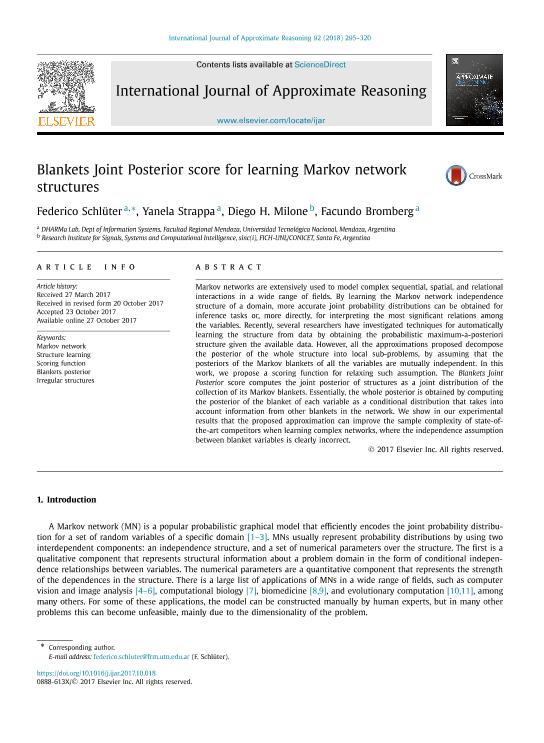Mostrar el registro sencillo del ítem
dc.contributor.author
Schluter, Federico Enrique Adolfo

dc.contributor.author
Strappa Figueroa, Yanela Daiana

dc.contributor.author
Milone, Diego Humberto

dc.contributor.author
Bromberg, Facundo

dc.date.available
2019-11-25T21:39:57Z
dc.date.issued
2018-01
dc.identifier.citation
Schluter, Federico Enrique Adolfo; Strappa Figueroa, Yanela Daiana; Milone, Diego Humberto; Bromberg, Facundo; Blankets Joint Posterior score for learning Markov network structures; Elsevier Science Inc; International Journal Of Approximate Reasoning; 92; 1-2018; 295-320
dc.identifier.issn
0888-613X
dc.identifier.uri
http://hdl.handle.net/11336/90382
dc.description.abstract
Markov networks are extensively used to model complex sequential, spatial, and relational interactions in a wide range of fields. By learning the Markov network independence structure of a domain, more accurate joint probability distributions can be obtained for inference tasks or, more directly, for interpreting the most significant relations among the variables. Recently, several researchers have investigated techniques for automatically learning the structure from data by obtaining the probabilistic maximum-a-posteriori structure given the available data. However, all the approximations proposed decompose the posterior of the whole structure into local sub-problems, by assuming that the posteriors of the Markov blankets of all the variables are mutually independent. In this work, we propose a scoring function for relaxing such assumption. The Blankets Joint Posterior score computes the joint posterior of structures as a joint distribution of the collection of its Markov blankets. Essentially, the whole posterior is obtained by computing the posterior of the blanket of each variable as a conditional distribution that takes into account information from other blankets in the network. We show in our experimental results that the proposed approximation can improve the sample complexity of state-of-the-art competitors when learning complex networks, where the independence assumption between blanket variables is clearly incorrect.
dc.format
application/pdf
dc.language.iso
eng
dc.publisher
Elsevier Science Inc

dc.rights
info:eu-repo/semantics/openAccess
dc.rights.uri
https://creativecommons.org/licenses/by-nc-nd/2.5/ar/
dc.subject
BLANKETS POSTERIOR
dc.subject
IRREGULAR STRUCTURES
dc.subject
MARKOV NETWORK
dc.subject
SCORING FUNCTION
dc.subject
STRUCTURE LEARNING
dc.subject.classification
Ciencias de la Computación

dc.subject.classification
Ciencias de la Computación e Información

dc.subject.classification
CIENCIAS NATURALES Y EXACTAS

dc.title
Blankets Joint Posterior score for learning Markov network structures
dc.type
info:eu-repo/semantics/article
dc.type
info:ar-repo/semantics/artículo
dc.type
info:eu-repo/semantics/publishedVersion
dc.date.updated
2019-10-22T17:41:08Z
dc.journal.volume
92
dc.journal.pagination
295-320
dc.journal.pais
Estados Unidos

dc.description.fil
Fil: Schluter, Federico Enrique Adolfo. Universidad Tecnológica Nacional. Facultad Regional de Mendoza; Argentina. Consejo Nacional de Investigaciones Científicas y Técnicas; Argentina
dc.description.fil
Fil: Strappa Figueroa, Yanela Daiana. Universidad Tecnológica Nacional. Facultad Regional de Mendoza; Argentina. Consejo Nacional de Investigaciones Científicas y Técnicas; Argentina
dc.description.fil
Fil: Milone, Diego Humberto. Consejo Nacional de Investigaciones Científicas y Técnicas. Centro Científico Tecnológico Conicet - Santa Fe. Instituto de Investigación en Señales, Sistemas e Inteligencia Computacional. Universidad Nacional del Litoral. Facultad de Ingeniería y Ciencias Hídricas. Instituto de Investigación en Señales, Sistemas e Inteligencia Computacional; Argentina
dc.description.fil
Fil: Bromberg, Facundo. Universidad Tecnológica Nacional. Facultad Regional de Mendoza; Argentina. Consejo Nacional de Investigaciones Científicas y Técnicas; Argentina
dc.journal.title
International Journal Of Approximate Reasoning

dc.relation.alternativeid
info:eu-repo/semantics/altIdentifier/doi/http://dx.doi.org/10.1016/j.ijar.2017.10.018
dc.relation.alternativeid
info:eu-repo/semantics/altIdentifier/url/https://www.sciencedirect.com/science/article/pii/S0888613X17302189
Archivos asociados
